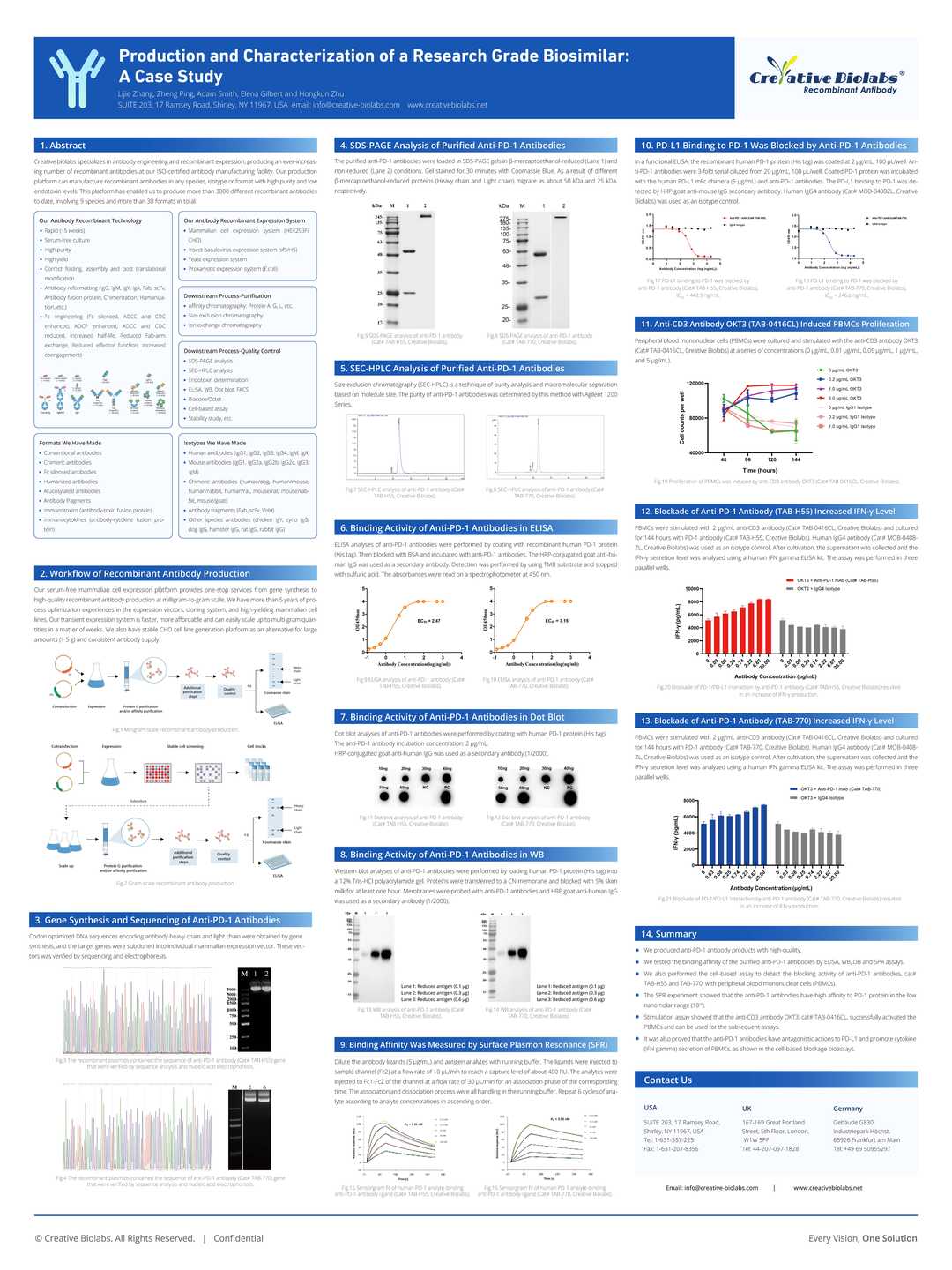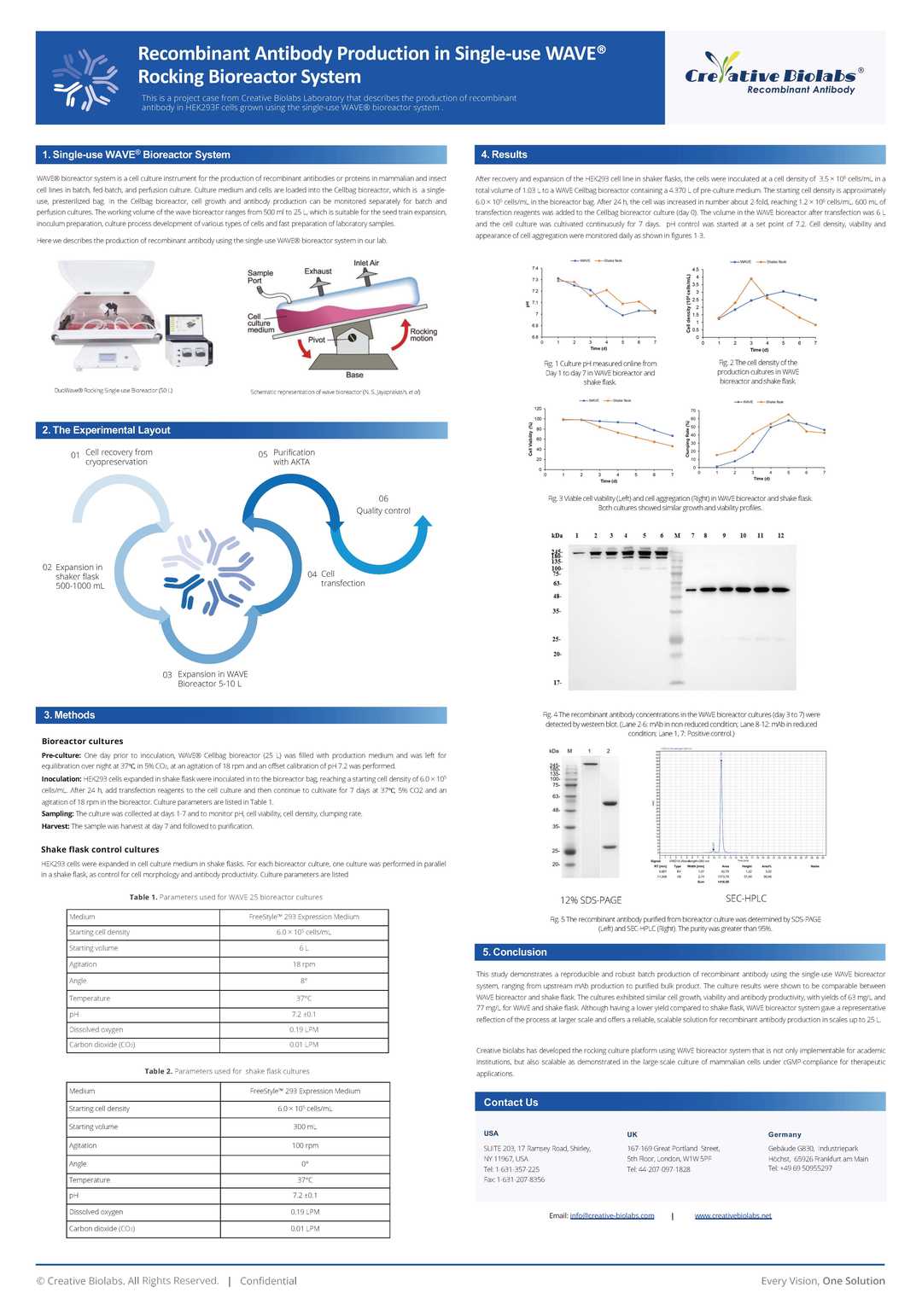anti-EPCAM immunotoxin MOC31 (IgG)-PE
CAT#: AGTO-L013E
This immunotoxin was achieved by conjugating/fusing the Anti-EPCAM monoclonal antibody to Pseudomonas exotoxin. It was expressed in CHO and purified with affinity chromatography. The immunotoxin selectively binds to carcinoma cells and enters cells by receptor-mediated endocytosis, then PE cleaved fragments the size of Mr 37000 and 27000, the large fragment and finally into the Golgi and elongation factor 2 (EM) combining it glycosylation inactivation, inhibition of protein synthesis, leading to apoptosis. It was designed for treatment of cancers.





Specifications
- Host Species
- Mouse
- Cell Penetrating Peptide
- P16422
- Species Reactivity
- Human
- Clone
- MOC31
- Molecule Class
- L kappa; IgG1-PE
- Toxin Description
- Pseudomonas aeruginosa exotoxin (Pseudomonas Aeruginosa Exotoxin A, PE) is a cell toxin produced by P. aeruginosa. Divided into three domains in space. DomainIII (s 405~613 amino acids) having ADP ribosylation activity, can inhibit protein synthesis, PE on toxicity mechanisms of cell depends on its Domainlll. After PE molecules into mammals, Domain Ia and widely distributed in mammalian cells α 2 macroglobulin receptor binding was endocytic, then PE cleaved fragments the size of Mr 37000 and 27000, the large fragment and finally into the Golgi and elongation factor 2 (EM) combining it glycosylation inactivation, inhibition of protein synthesis, leading to apoptosis.
- Applications
- This product is suitable for use in cytotoxicity assay, functional assay and immunotherapy.
- Related Disease
- Hepatocellular carcinomas (HCC)
Target
- Alternative Names
- EPCAM; epithelial cell adhesion molecule; ESA; KSA; M4S1; MK-1; DIAR5; EGP-2; EGP40; KS1/4; MIC18; TROP1; EGP314; HNPCC8; TACSTD1; epithelial glycoprotein 314; human epithelial glycoprotein-2; cell surface glycoprotein Trop-1; adenocarcinoma-associated antigen; tumor-associated calcium signal transducer 1; major gastrointestinal tumor-associated protein GA733-2; membrane component, chromosome 4, surface marker (35kD glycoprotein); Hepatocellular carcinomas; HCC; Pseudomonas exotoxin; Pseudomonas exotoxin A; Pseudomonas aeruginosa exotoxin; Pseudomonas aeruginosa exotoxin A; PE; PE38; PE40; ETA; PE33; PE35
- Gene ID
- 4072
- UniProt ID
- P16422
Customer Review
There are currently no Customer reviews or questions for AGTO-L013E. Click the button above to contact us or submit your feedback about this product.



Q&As
-
How do I perform antibody titration for my experiment?
A: To titrate this antibody, prepare a serial dilution series, and test each dilution in your assay. This will help you determine the optimal concentration that provides the best signal-to-noise ratio.
-
Are there special handling instructions for this antibody?
A: Handle the antibody with care, avoiding contamination. Use sterile techniques, aliquot to avoid multiple freeze-thaw cycles, and follow storage instructions closely to maintain efficacy.
-
Is it necessary to include a blocking step in my protocol?
A: Yes, including a blocking step using agents like BSA or non-fat dry milk is essential to reduce non-specific binding and background noise, thereby improving the assay specificity.
View the frequently asked questions answered by Creative Biolabs Support.
Submit Your Publication
Published with our product? Submit your paper and receive a 10% discount on your next order! Share your research to earn exclusive rewards.
Downloadable Resources
Download resources about recombinant antibody development and antibody engineering to boost your research.
Product Notes
This is a product of Creative Biolabs' Hi-Affi™ recombinant antibody portfolio, which has several benefits including:
• Increased sensitivity
• Confirmed specificity
• High repeatability
• Excellent batch-to-batch consistency
• Sustainable supply
• Animal-free production
See more details about Hi-Affi™ recombinant antibody benefits.
Datasheet
MSDS
COA
Certificate of Analysis LookupTo download a Certificate of Analysis, please enter a lot number in the search box below. Note: Certificate of Analysis not available for kit components.
See other products for "Clone MOC31"
- CAT
- Product Name
See other products for "EPCAM"
Select a product category from the dropdown menu below to view related products.
| CAT | Product Name | Application | Type |
|---|---|---|---|
| TAB-213 | Humanized Anti-EPCAM Recombinant Antibody (clone Tucotuzumab) | WB, Neut, ELISA, IF, IP, FuncS, FC | Humanized (from mouse) IgG1 |
| TAB-112-F(E) | Anti-Human EpCAM Recombinant Antibody Fab Fragment, 17-1A (Citatuzumab Bogatox) | Neut, ELISA, IF, IP, FuncS, FC, ICC | Fab - G1 - kappa |
| TAB-374MZ | Anti-Human EPCAM Recombinant Antibody (h12H8B) | FC, ELISA | Humanized antibody |
| TAB-375MZ | Anti-Human EPCAM Recombinant Antibody (h12H8C) | FuncS, Inhib | Humanized antibody |
| TAB-376MZ | Anti-Human EPCAM Recombinant Antibody (h2D11B) | Cyt, Inhib | Humanized antibody |
| CAT | Product Name | Application | Type |
|---|---|---|---|
| AGTO-L013D | anti-EPCAM immunotoxin MOC31 (IgG)-DT | Cytotoxicity assay, Functional assay | |
| AGTO-L013G | anti-EPCAM immunotoxin MOC31 (IgG)-Gel | Cytotoxicity assay, Functional assay | |
| AGTO-L013R | anti-EPCAM immunotoxin MOC31 (IgG)-RTA | Cytotoxicity assay, Functional assay | |
| AGTO-L013O | anti-EPCAM immunotoxin MOC31 (IgG)-Bouganin | Cytotoxicity assay, Functional assay |
| CAT | Product Name | Application | Type |
|---|---|---|---|
| TAB-0531CL-F(E) | Anti-Human EPCAM Recombinant Antibody Fab Fragment (HE2) | ELISA, Inhib | |
| TAB-363MZ | Mouse Anti-EPCAM Recombinant Antibody (TAB-363MZ) | ELISA, FuncS | Mouse IgG1, κ |
| TAB-364MZ | Mouse Anti-EPCAM Recombinant Antibody (TAB-364MZ) | FC | Mouse IgG1 |
| TAB-365MZ | Mouse Anti-EPCAM Recombinant Antibody (TAB-365MZ) | FC | Mouse IgG1 |
| TAB-366MZ | Mouse Anti-EPCAM Recombinant Antibody (TAB-366MZ) | ELISA, FC | Mouse IgG |
| CAT | Product Name | Application | Type |
|---|---|---|---|
| TAB-356MZ | Anti-Human EPCAM Recombinant Antibody (3-171) | Cyt, ELISA, FC, WB | Human antibody |
| TAB-357MZ | Anti-Human EPCAM Recombinant Antibody (7-F17) | ELISA | Human antibody |
| TAB-358MZ | Anti-Human EPCAM Recombinant Antibody (12-C15) | ELISA | Human antibody |
| TAB-359MZ | Anti-Human EPCAM Recombinant Antibody (16-G5) | ELISA | Human antibody |
| TAB-360MZ | Anti-Human EPCAM Recombinant Antibody (17-C20) | ELISA | Human antibody |
| CAT | Product Name | Application | Type |
|---|---|---|---|
| MOR-1163 | Hi-Affi™ Rabbit Anti-EPCAM Recombinant Antibody (clone DS1163AB) | IHC-P, WB, ICC, ICC, IF | Rabbit IgG |
| CAT | Product Name | Application | Type |
|---|---|---|---|
| MOB-074LC | Human Anti-EPCAM Recombinant Antibody (clone ING-1) | ELISA, FuncS | Humanized IgG1, κ |
| HPAB-2219LY | Human Anti-EPCAM Recombinant Antibody (HPAB-2219LY) | ELISA | Human IgG |
| HPAB-2220LY | Human Anti-EPCAM Recombinant Antibody (HPAB-2220LY) | ELISA | Human IgG |
| HPAB-2221LY | Human Anti-EPCAM Recombinant Antibody (HPAB-2221LY) | ELISA | Human IgG |
| HPAB-2222LY | Human Anti-EPCAM Recombinant Antibody (HPAB-2222LY) | ELISA | Human IgG |
| CAT | Product Name | Application | Type |
|---|---|---|---|
| FAMAB-0095-YC-S(P) | Mouse Anti-EPCAM Recombinant Antibody (clone MOC31); scFv Fragment | ELISA | Mouse scFv |
| HPAB-2218LY-S(P) | Human Anti-EPCAM Recombinant Antibody; scFv Fragment (HPAB-2218LY-S(P)) | ELISA | Human scFv |
| HPAB-2219LY-S(P) | Human Anti-EPCAM Recombinant Antibody; scFv Fragment (HPAB-2219LY-S(P)) | ELISA | Human scFv |
| HPAB-2220LY-S(P) | Human Anti-EPCAM Recombinant Antibody; scFv Fragment (HPAB-2220LY-S(P)) | ELISA | Human scFv |
| HPAB-2221LY-S(P) | Human Anti-EPCAM Recombinant Antibody; scFv Fragment (HPAB-2221LY-S(P)) | ELISA | Human scFv |
| CAT | Product Name | Application | Type |
|---|---|---|---|
| MRO-0538-CN | Mouse Anti-EPCAM Recombinant Antibody (clone 3-E1-E2) | WB, IF, IHC, FC | Mouse IgM |
| CAT | Product Name | Application | Type |
|---|---|---|---|
| AFC-TAB-106 | Afuco™ Anti-EPCAM ADCC Recombinant Antibody, ADCC Enhanced (AFC-TAB-106) | ELISA, IP, FC, FuncS, Neut | ADCC enhanced antibody |
| AFC-TAB-213 | Afuco™ Anti-EPCAM ADCC Recombinant Antibody, ADCC Enhanced (AFC-TAB-213) | Neut, ELISA, IF, IP, FuncS | ADCC enhanced antibody |
| AFC-TAB-701 | Afuco™ Anti-EpCAM ADCC Recombinant Antibody, ADCC Enhanced (AFC-TAB-701) | ELISA, IP, FC, FuncS, IF, Neut | ADCC enhanced antibody |
| CAT | Product Name | Application | Type |
|---|---|---|---|
| HPAB-2216LY-F(E) | Human Anti-EPCAM Recombinant Antibody; Fab Fragment (HPAB-2216LY-F(E)) | ELISA | Human Fab |
| HPAB-2217LY-F(E) | Human Anti-EPCAM Recombinant Antibody; Fab Fragment (HPAB-2217LY-F(E)) | ELISA | Human Fab |
| HPAB-2218LY-F(E) | Human Anti-EPCAM Recombinant Antibody; Fab Fragment (HPAB-2218LY-F(E)) | ELISA | Human Fab |
| HPAB-2219LY-F(E) | Human Anti-EPCAM Recombinant Antibody; Fab Fragment (HPAB-2219LY-F(E)) | ELISA | Human Fab |
| HPAB-2220LY-F(E) | Human Anti-EPCAM Recombinant Antibody; Fab Fragment (HPAB-2220LY-F(E)) | ELISA | Human Fab |
| CAT | Product Name | Application | Type |
|---|---|---|---|
| MHC-CN0031 | APC-H-2Db/Human Ep-CAM (CLVMKAEM) MHC Tetramer | FCM | |
| MHC-CN0032 | PE-H-2Db/Human Ep-CAM (CLVMKAEM) MHC Tetramer | FCM |
| CAT | Product Name | Application | Type |
|---|---|---|---|
| VS-0724-YC1517 | AbPlus™ Anti-EPCAM Magnetic Beads (VS-0724-YC1517) | IP, Protein Purification |
| CAT | Product Name | Application | Type |
|---|---|---|---|
| VS-0924-YC37 | Mouse Anti-EPCAM Recombinant Antibody (VS-0924-YC37) - Cancer Stem Cell Marker | IHC, WB | Mouse IgG1 |
| VS-0924-YC38 | Rabbit Anti-EPCAM Antibody (VS-0924-YC38) - Cancer Stem Cell Marker | IHC, WB | Rabbit IgG |
| CAT | Product Name | Application | Type |
|---|---|---|---|
| VS-0125-FY18 | Human Anti-EpCAM (clone 3-171) scFv-Fc Chimera | Cyt, ELISA, FC, WB | Human IgG1, scFv-Fc |
| CAT | Product Name | Application | Type |
|---|---|---|---|
| VS-0225-XY107 | CytoStream™ Mouse Anti-EPCAM Recombinant Antibody (VS-0225-XY107) | FC | Mouse IgG2b, kappa |
| CAT | Product Name | Application | Type |
|---|---|---|---|
| VS-0325-XY773 | Anti-EPCAM Immunohistochemistry Kit | IHC | |
| VS-0525-XY2307 | Anti-Human EPCAM Immunohistochemistry Kit | IHC | |
| VS-0525-XY2308 | Anti-Mouse EPCAM Immunohistochemistry Kit | IHC | |
| VS-0525-XY2309 | Anti-Canine EPCAM Immunohistochemistry Kit | IHC |
| CAT | Product Name | Application | Type |
|---|---|---|---|
| VS-0425-YC210 | Recombinant Anti-EPCAM Vesicular Antibody, EV Displayed (VS-0425-YC210) | ELISA, FC, Neut, Cell-uptake |
| CAT | Product Name | Application | Type |
|---|---|---|---|
| VS-0525-YC214 | Recombinant Anti-EpCAM (Exon 2 x Exon 5) Biparatopic Antibody, Tandem scFv (Edrecolomab x Adecatumumab) | ELISA, FC | Tandem scFv |
Popular Products

Application: Neut, ELISA, IF, IP, FuncS, FC, IHC

Application: IP, IF, FuncS, FC, Neut, ELISA, ICC

Application: ELISA, FC, IP, FuncS, IF, Neut, ICC

Application: FuncS, IF, Neut, ELISA, FC, IP, ICC

Application: IF, IP, Neut, FuncS, ELISA, FC, ICC

Application: FuncS, IF, Neut, ELISA, FC, IP, ICC
-2-1.png)
Application: IP, IF, FuncS, FC, Neut, ELISA, IHC

Application: IHC, ELISA, FC, WB, ADCC, FuncS

Application: ELISA, IHC, FC, IP, IF, FuncS

Application: ELISA, FC, Neut, Inhib

Application: Neut, FuncS, IHC, ELISA, FC, Inhib
For research use only. Not intended for any clinical use. No products from Creative Biolabs may be resold, modified for resale or used to manufacture commercial products without prior written approval from Creative Biolabs.
This site is protected by reCAPTCHA and the Google Privacy Policy and Terms of Service apply.





















